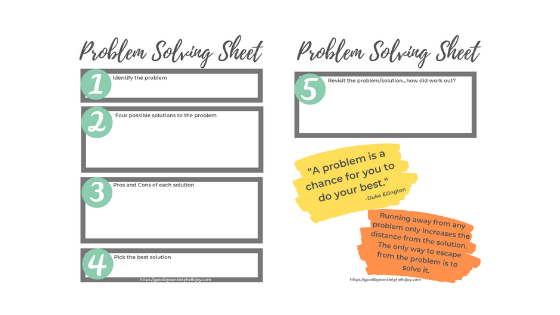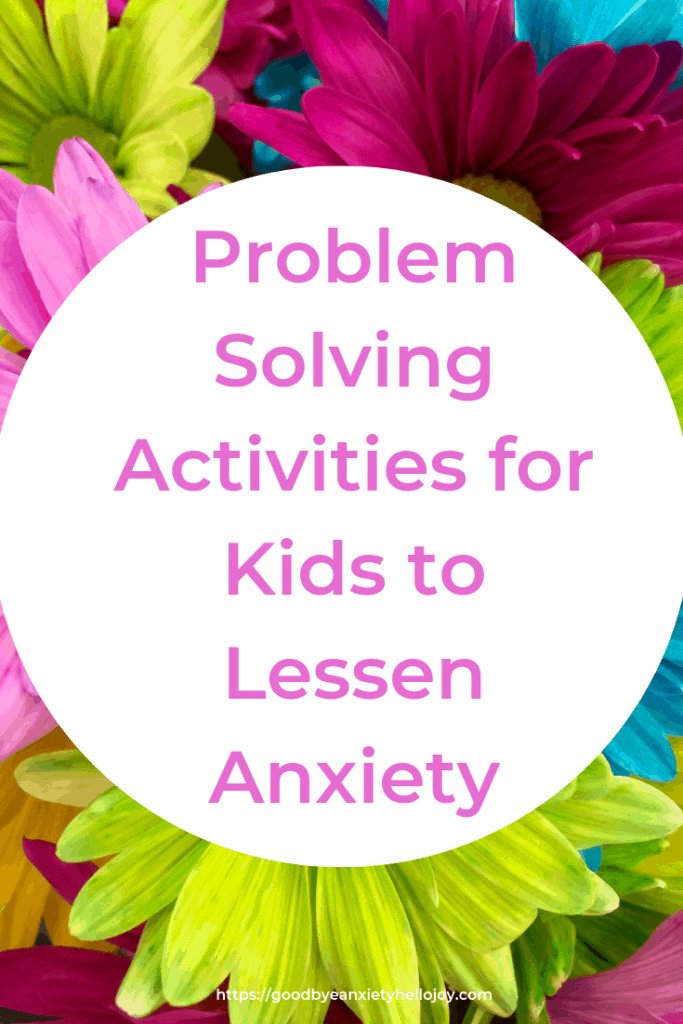Problem Solving Activities for Kids to Lessen Anxiety
All children face challenges, problems, and discomfort at some point each day. It may be a challenging reading passage, difficulty opening the packaging of their snack, forgetting their locker combination, or feeling angry at a friend. Parents cannot be expected to solve every problem for their child. You must teach your child how to solve these problems when they arise. Fortunately, there are several problem-solving activities for kids that teach children the skills needed for independence.
Young children encounter problems when reaching for something high, finding a knot in their shoelace, or feeling confused when reading a new word. Older kids must deal with peers at school, forgotten homework, unhappiness with their parent’s rules, or losing a necessary piece of sporting equipment prior to a game. As with most tasks related to children, the language and strategies used will vary based on a child’s age, but the ideas apply to everyone. These problem-solving activities for kids will help teach all children the steps needed to work through and solve their problem.
How Weak Problem Solving Skills Affect Kids
Without the proper skills, children may react by hitting a peer, fall behind academically, act out at home, or refuse to attend the required game. These actions can lead to social problems among classmates, difficult dynamics at home, and feelings of despair for the child. Over time, children without problem-solving skills may begin to avoid situations altogether.
It takes time, practice, and maturity to become independent problem solvers. For children with anxiety, their ability to solve problems is very weak. Rather than put their energy into solving the problem, they may invest their time into avoiding the issue. As anxious children become problem solvers, it tends to lower their anxiety in many situations. It leads to independence and confidence. The goal is to teach children the needed skills to problem solve, allowing them to access their knowledge for any type of situation that arises.
Teach Your Child How to Solve A Problem
Solving the problem: These steps should be taught to all children and placed in a visible location in the classroom as a reminder. For many anxious children, these steps can be used during structured breaks to work through the anxiety caused by the problem.
- Identify the problem- Verbalize or write down the problem. For example: “I forgot my homework at home and it is due today. Now I will miss recess.”
- List at least 4 solutions to the problem- These do not have to feasible solutions, just any ideas that come to mind. For example: “I could call my mom. I could walk home and get it. I could talk to the teacher and see if I can turn it in tomorrow. I could ask for another copy and do it at recess.”
- Talk through the pros and cons of each of the ideas- Listen to the child to share their thoughts and then add your own only if something needs to be clarified or expounded upon. For example: “My mom is at work so she probably will not be able to leave work and bring it to me. I live too far away to walk home. The teacher will like that I am honest and probably let me turn it in late although I may lose a few points. I could do it at recess but I really want to play with my friends.”
- Pick the best solution- This can be tricky because kids with anxiety may not want to pick any of the solutions, as they may see something “wrong” with every idea. In this case, help guide them towards the best solution to their problem. For example: “I guess turning it in tomorrow is the best idea here but I am not happy that I may lose a few points for being late.”
- Revisit the problem/solution once the action is complete to decide if the solution was successful. If not, discuss what can be done in the future in similar situations.
 You can access this free PDF printable in the freebie library. This simple outline of problem solving can be used for nearly every situation a child encounters. Over time and through practice, the majority of the minor problems with be solved without the needed steps above. However, for bigger problems, helping a child solve them rather than solving it for them leads to less anxiety and greater confidence and independence.
You can access this free PDF printable in the freebie library. This simple outline of problem solving can be used for nearly every situation a child encounters. Over time and through practice, the majority of the minor problems with be solved without the needed steps above. However, for bigger problems, helping a child solve them rather than solving it for them leads to less anxiety and greater confidence and independence.
Model Effective Problem Solving Skills
Parents should model their problem-solving skills for kids by sharing their thoughts as they work through a problem. This can be done in “real-time” as the problem is occurring or in a more structured time for “role-playing”. It is important that children see adult pausing to think through the situation. It is important to share your emotions as you work through the problem. We want children to see that it is normal to feel frustrated, angry, or disappointed when faced with a problem. Similarly, we want children to see that mistakes happen, but can be overcome.
For children with anxiety, this is particularly important, as their anxiety, when not managed well, cuts out all problem-solving skill and goes immediately to avoidance or reassurance from adults. They need to routinely witness other people working through uncertainty and discomfort, yet coming out of the problem with success.
An example of thinking out loud would sound something like this: “This morning as I was getting ready for work, the dog ran out the front door. Right away I started to think that I would never find her and I was so upset I started to cry. Then, I remembered that she had done this last month and I found her in the neighborhood visiting another dog. Even though I knew I would be late for work, I put on my shoes to go outside and look for her. I did not see her right away and I was nervous but I kept yelling her name. Finally, I saw her running back towards me. I was so happy that I stopped freaking out at the door and remembered to go look outside for her. I will definitely make sure my door is closed tight from now on.”
Play Games and Participate in Activities that Require Problem Solving
It is important that children experience activities and events that take thought and time in order to complete. As much as I dislike video games, many do provide opportunities to problem-solve. Be aware of games that your child is playing and discuss what skills they used to complete a challenge or win the game. Similarly, spend time together working on a puzzle or Sudoku challenges. These allow opportunities to discuss the thoughts that arise when fitting in the puzzle piece for correct numbers.
Building with Legos or creating artwork allows for problem-solving skills as they work through the process of bringing their vision to life. Children will make mistakes and become frustrated, but that is part of moving through life with success. For anxious children, who question their abilities or fear to make mistakes, this is very difficult. Through practice, they gain the experience of thinking through their actions and responses to mistakes. They also witness others trying techniques, sharing their thoughts and feelings, and working their mistakes.
Over time, a child’s ability to properly handle difficult situations will improve, leading to greater confidence and less avoidance.

[…] them to explore solutions to their problems. It is always a good idea to see what your child comes up with in terms of their own solutions […]